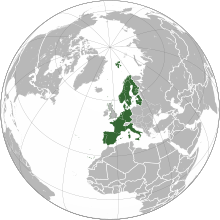European Union
| This article is under construction. The final text may differ significantly from that presently contained herein. |
| ||||||||||||||||||||||||||||||||||||||||||||||||||||||||||||||||||||||||||||||||||||||||||||||||||||||||||||||||||||||||||||||||||||||||||||
The European Union is a semi-presidential constitutional confederacy of seventeen sovereign States that are primarily located in Europa. The European Union has an area of 8,614,876 km2 (3,326,222 mi²), and an estimated population (as of 1721) of 629,071,576. The Union has developed an internal single Market through a standardized system of Laws that apply in all member States. Union policies aim to ensure the free movement of people, goods, services, and capital within the internal Market. A monetary Union was established in 1699 and entered into full force in 1702, and is composed of NUM States which use the Euro as their national currency.
The European Union traces its origin to the European Coal and Steel Community (ECSC) and the European Atomic Energy Community (EURATOM), formed by the Inner Six countries in 1651 and 1658, respectively.
History[edit | edit source]
XXXX
Evolution through treaties[edit | edit source]
XXXX
Geography[edit | edit source]
XXXX
Climate[edit | edit source]
XXXX
Topography[edit | edit source]
XXXX
Geology[edit | edit source]
XXXX
Natural hazards[edit | edit source]
XXXX
Natural and mineral resources[edit | edit source]
XXXX
Environment[edit | edit source]
XXXX
Member States[edit | edit source]
XXXX Template:European Union members table
Government and politics[edit | edit source]
XXXX
Competences[edit | edit source]
Template:EuropeanUnion competences XXXX
Legal system[edit | edit source]
XXXX
Acts[edit | edit source]
XXXX
Government[edit | edit source]
XXXX
Legislature[edit | edit source]
XXXX
XXXX
XXXX
Executive[edit | edit source]
Head of State: European Council[edit | edit source]
Composed of the heads of state and government of the various member States of the European Union, the European Council is the collective head of state and collective presidency of the European Union. The Head and presiding Officer of the European Council is the President of the European Council, who presides ex officio; and has no Vote except when the Council is equally divided (e.g., he cannot vote except to break a tie). Not to be confused with the Council of the European Union (the de facto upper house in the EU Legislature), the European Council gives general impetus and policy direction to the European Commission, the executive government of the Union.
Head of Government: European Commission[edit | edit source]
XXXX
Template:European Federal Government table The day-to-day task of running of the Union’s executive branch, the European Commission, is the responsibility of the President of the European Commission. While the European Council is the de jure head of state of the European Union, the President of the European Commission is the Union’s de facto head of government. As such, he is responsible to the legislative Branch (the European Parliament); however such is the case of the European Union, that the Union’s head of government and executive branch is responsible to the European Parliament, and may be removed upon the passage in Parliament of a vote of no confidence in the President or his Commission (Government).
Ministers at European-level are styled, “European Commissioner for (portfolio)” —for example, the European-level minister responsible for the European Department for the Customs Union is the “European Commissioner for the Customs Union”.
Judiciary[edit | edit source]
XXXX
Budget[edit | edit source]
XXXX
Economy[edit | edit source]
XXXX
Internal market[edit | edit source]
XXXX
Competition[edit | edit source]
XXXX
Monetary union[edit | edit source]
XXXX
Taxation[edit | edit source]
XXXX
Tourism[edit | edit source]
XXXX
Infrastructure[edit | edit source]
XXXX
Science and technology[edit | edit source]
XXXX
Transportation[edit | edit source]
XXXX
Energy[edit | edit source]
- Further information: Electricity sector of the European Union (by source: biomass, coal, geothermal, hydro, natural gas, nuclear, oil, solar, tidal, and wind) (by member State)
XXXX
Education[edit | edit source]
XXXX
Health[edit | edit source]
XXXX
Demographics[edit | edit source]
XXXX
Age and gender[edit | edit source]
XXXX
Ethnic groups[edit | edit source]
XXXX
Immigration and emigration[edit | edit source]
Language[edit | edit source]
XXXX
Religion[edit | edit source]
XXXX
Urbanization[edit | edit source]
XXXX
Wealth[edit | edit source]
XXXX
See also[edit | edit source]
Notes[edit | edit source]
- Articles containing non-Basic-language text
- Pages with broken file links
- European Union
- States and territories in Europa
- States and territories in Southern Europa
- States and territories in Central Europa
- States and territories in Northern Europa
- States and territories in Western Europa
- States and territories established in 1693
- Supranational political communities
- Supranational unions
- Staatenverbunds
- Supranational bodies politic and corporate
- Federal bodies politic and corporate
- Parliamentary bodies politic and corporate
- Republican bodies politic and corporate
- Members of the United Nations Organization
- Members of the Council of Europa


